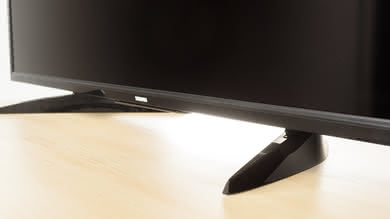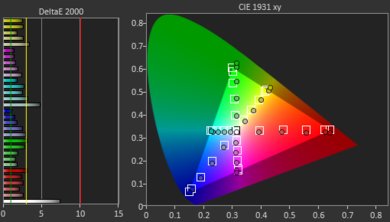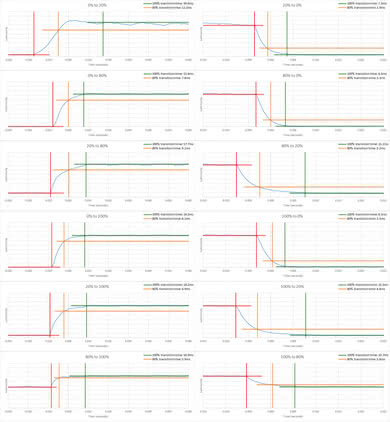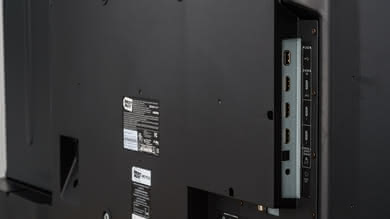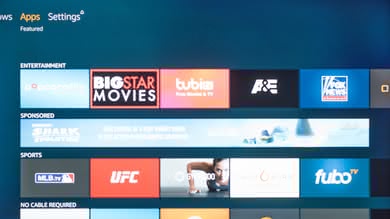Our Verdict
The Toshiba Fire TV is a decent TV for mixed usage. It does not excel in any particular area, but it performs decently in almost all. It is very responsive due to its fast response time and low input lag and is suitable for a relatively bright room. However, the image quality deteriorates when viewing it from the side and it will display some uniformity issues that can annoy some people.
- Deep and uniform dark scenes
- Powerful Alexa voice assistant
- Image degrades when viewed at an angle
- Mediocre HDR
- Many functions require an Amazon Prime account
The Toshiba Fire TV has mediocre performance when watching movies. Although contrast is excellent and blacks will look deep in a dark movie watching environments, the TV cannot produce rich, saturated colors and its color accuracy is sub-par. Watching movies is not one of the strong usages of this.
The Toshiba Fire TV is decent for watching TV shows. It has good SDR brightness and can handle reflections decently so you can place it in a fairly bright room but avoid having too many light sources. It handles upscaling cable content well but the viewing angle is bad and the image loses accuracy when viewed from the side. So to enjoy your favorite TV show you should sit mostly directly in front of the TV.
Sports watching on the Fire TV is okay. It has decent reflection handing for a bright room but poor viewing angles so it is not suitable for wide viewing. Although it has a fast response time, motion handling is just mediocre, and gray uniformity is sub-par, so some people will notice some clouding in hockey or football wide panning shots.
The Toshiba Fire TV is good for occasional video game playing. It has a fast response time and a good low input lag that will keep the infrequent gamer happy. It lacks, however, more advanced gaming features like variable refresh rate (VRR) or black frame insertion (BFI) that more hardcore gamers are looking for.
Watching HDR movies on this Fire TV is ok. Blacks look great in dark rooms, but the color gamut is limited and HDR highlights are not well displayed, and certainly not to the expectations of their creator. Just like movie watching, HDR content playback is not one of this TVs strong usages.
The Toshiba Fire TV is decent for HDR gaming. It has a very good low input lag for the 4k @ 60Hz + HDR resolution and an impressive response time, but at the same time the color gamut is limited and the TV cannot display rich or even accurate colors.
Decent performance for this Fire TV as a PC monitor. It has a very good low input lag and fast response time, but at the same time, viewing angles are poor thus if you sit too close the image at the edges will not look accurate. You should not worry about permanent burn-in Risk, or temporary image retention, as this is a VA panel which seems to be immune to those risks.
Changelog
- Updated May 21, 2020: Converted to Test Bench 1.5.
- Updated Feb 21, 2020: Converted to Test Bench 1.4.
- Updated Feb 28, 2019: Converted to Test Bench 1.3.
- Updated Jul 10, 2018: Review published.
Check Price
Differences Between Sizes And Variants
We tested the 55" (55LF621U19). For the most part, we expect our review to be valid for other sizes.
If someone comes across a different type of panel or if their Toshiba Fire TV 55LF621U19 that doesn't correspond to our review, let us know and we will update the review.
| Size | Model |
| 43" | 43LF621U19 |
| 50" | 50LF621U19 |
| 55" | 55LF621U19 |
Update 07/23/2018: We have received reports that the 43" and 50" models do not support motion interpolation as they lack the Motion Processing option.
Popular TV Comparisons

The Toshiba Fire TV is a mediocre TV, especially compared to the capable competition found in its price range. See our recommendations for the best cheap TVs and the best TVs under $300.
The Vizio E Series 2018 is much better than the Toshiba Amazon Fire TV 2018. The Vizio has local dimming and Dolby Vision support, it also has better color gamut and color volume and thus, it can display HDR content slightly better. The Vizio has lower input lag, which is great if you play video games or use the TV as a PC monitor. Finally, the Vizio has a faster response time so it can display fast-moving content with less blur. The Toshiba Fire TV 2018, on the other hand, supports motion interpolation for the soap opera effect enthusiasts and can upscale better cable input, which is important if you watch a lot of TV shows or sports.
The Samsung NU7100 is better than the Toshiba Amazon Fire TV 2018. The Samsung NU7100 has a lower input lag, which is great if you play video games or use the TV as a PC monitor. The Samsung NU7100 also has better black and gray uniformity that improve picture quality and better reflection handling, which allows you to place the TV in a room with many small windows. On the other hand, the Toshiba Fire TV 2018 can get brighter, so it can fight the glare of bright rooms better, and it has better handling of fast motion due to the faster response time.
The TCL S Series/S405 4k 2018 is better than the Toshiba Amazon Fire TV 2018. The TCL S405 has better reflection handling if you wish to place the TV in a room with many light sources, and also has better out-of-the-box color accuracy. The TCL S405 has lower input lag and is very responsive for gaming or when used as a PC monitor. On the other hand, the Toshiba Fire TV 2018 can get much brighter and can fight glare in a bright room. Finally, the Toshiba Fire TV 2018 has a motion interpolation feature for those who like the soap opera effect.
The TCL S517 is better than the Toshiba Amazon Fire TV 2018. The TCL S517 has a much better input lag, which is great for gamers and better color gamut and color volume that are important for better HDR performance. Also, the TCL S517 has better reflection handling, and this is great if you like to watch TV shows in a bright room. On the other hand, the Toshiba Fire TV 2018 can get brighter to fight ambient glare and has better black uniformity, which improves the picture quality of dark scenes in a dark room.

We buy and test dozens of TVs yearly, taking an objective, data-driven approach to deliver results you can trust. Our testing process is complex, with hundreds of individual tests that take over a week to complete. Most of our tests are done with specially designed test patterns that mimic real content, but we also use the same sources you have at home to ensure our results match the real-world experience. We use two main tools for our testing: a Colorimetry Research CR-100 colorimeter and a CR-250 spectroradiometer.
Test Results
The design of this Toshiba Fire TV Edition is decent. It is made of plastic and does not have a premium look to it. Its build quality is ok with no gaps or other issues. It will get warm to the touch on the lower edge without that being a problem. The stand supports the TV well although some wobbling is to be expected. If you decide to wall mount it will not protrude much, and the inputs will be accessible as they are all facing outwards.
The stand of the Toshiba Fire TV Edition 2018 is plastic and curvy. It supports the TV well although the TV will wobble a little back and forth if knocked gently. It does not lift the TV very high from the table and it protrudes a little in front of the TV. This might prevent you from placing a soundbar in front.
Footprint of the 55" model: 29.1" x 12.1"
The back of the TV is plastic. Some of the inputs are facing sideways and some downwards to facilitate access in case of wall mounting. There is no planning for cable management.
The Toshiba Fire TV Edition 2018 does not support Local Dimming.
The Toshiba Fire TV has good SDR peak brightness. It sustains a remarkably steady level of brightness throughout the various window sizes which is great.
The HDR peak Brightness is decent. Just like in the SDR tests this TV sustains the same level of brightness at all window sizes. However the level is just not enough to accurately deliver the HDR content as intended by its creator.
If you find HDR content too dim see our HDR recommended settings.
The gray uniformity of the Toshiba Fire TV Edition is mediocre. Some clouding is apparent almost all over the screen and also in the middle. Thus some dirty screen effect is visible while watching sports. In darker images, things are slightly better but the shadows are not completely eliminated.
The viewing angles of the Toshiba Fire TV are bad. As soon as you deviate from the center, blacks look washed out, colors shift and eventually, brightness diminishes. This is not a good TV for viewing from the side.
The Toshiba Fire TV has a semi-gloss finish for diffusing reflections across the screen. It does a good job in less bright environments, but when in well-lit rooms the reflections can be a little distracting. This becomes more of a problem when the light source is facing the screen.
This TV has terrible out-of-the-box color settings. There are no preset picture modes to chose from and you can only 'play' with the Red, Green and Blue values. The White balance dE was at 10.38 and the color dE was at 5.55, both much higher than our threshold of 3 where people start noticing the inaccuracies. The colors were cold and a blueish tone was slightly apparent. Gamma was the closest to our target of 2.2
The color accuracy is passable after post calibration. You can only adjust three parameters Red, Green and Blue and choose a color mode. Thus we were not able to reduce neither the white balance dE nor the color dE, below our threshold of 3. The results were better with Gamma which was right on target at 2.2 and the color temperature which was much closer to our 6500K target.
You can find our recommended calibration settings here.
When viewing 4k images from up close, some sub-pixel dimming is visible which introduces artifacts. This may be a type of spatial dithering and results in a checkerboard effect similar to the TCL 5 Series. You can see this effect up close in our pixels photo here.
The color gamut of this TV is decent. It covers about 3/4 of the DCI P3 xy color space, but fails to reach the 67% of the Rec 2020 uv to be classified as having a wide color gamut.
The color accuracy at our normal 75% stimulus brightness is bad, because the TV is prioritizing brightness over color accuracy; however at 50% stimulus brightness the accuracy of P3 and Rec 2020 colors are vastly improved. This means that most HDR colors will have passable color accuracy, but very bright colors will be washed out.
In the Natural HDR picture mode, the TV's EOTF follows the target PQ curve fairly closely, with some over-brightening in dim shades. If you find HDR content too dark, you can set the Low Luminance Gamma setting to -5, which raises the EOTF and brightens most of the scene; enabling the HDR Tone Mapping setting in addition to the Gamma -5 setting brightens the EOTF even more. The EOTFs in the Game and PC picture modes are almost identical to that of Natural.
Disappointing color volume for this Toshiba Fire TV. The TV cannot fill the color volume mainly because of its limited color gamut. It cannot produce rich or vivid colors to please the viewers.
The Toshiba Fire TV has a very good gradient as many areas have no visible banding at all. There are a few spots of medium banding, however, such as in dark gray and green.
There is no gradient smoothing feature, but the noise reduction features may reduce banding in low-quality content.
We don't expect VA panels to experience permanent image retention, as the VA panel in our long-term test appears immune.
The Toshiba Fire TV Edition does not have a BFI option.
Decent motion interpolation performance, as it is nearly perfect during slow-moving shots and stops when there is too much motion.
Some artifacts were present during our testing when Motion Processing (Motion interpolation) was set to enhanced. Setting Motion Processing to standard or smooth makes the algorithm more conservative, and although motion is less smooth, there are also less artifacts present. So if you find artifacts bothersome, you should choose the lower setting.
Update 07/23/2018: We have received reports that the 43" and 50" models do not support motion interpolation as they lack the Motion Processing option.
The Toshiba Fire TV has a fast response time and thus will display some stutter in slow frame rate content. However, using motion interpolation can improve the situation by a lot.
When displaying 24fps content the TV will always have judder and there is no judder removal feature. The only way to remove judder is to enable motion interpolation (soap opera effect), but this makes motion look much smoother than normal and occasionally adds artifacts.
This TV does not support VRR.
This Toshiba Fire TV has good low input lag, but you must be careful to follow our settings described below to experience the lowest possible input lag.
4:4:4 chroma subsampling only shown properly when the signal is RGB, and only in the PC picture mode. In PC mode, when a 4k @ 60Hz @ RGB HDMI signal is first sent it will have low input lag (37.2 ms), but if the picture mode is changed and then changed back to PC, PC mode will no longer have low input lag (70.0 ms); luckily changing picture modes doesn't happen often in normal usage. The Motion Processing setting (motion interpolation) must be disabled for PC mode to have low input lag.
The Amazon Fire has a decent support of various input resolutions. Here are some of the resolutions restrictions that you should be aware:
4k @ 60Hz @ 4:4:4 or 4:2:2 is only supported when HDMI Input Mode is set to Mode 2 (2.0).
1080p @ 60 @ 4:4:4 and 4k @ 60 @ 4:4:4 is only properly displayed in RGB. When in YCbCr chroma, 4:4:4 is not properly displayed.
4k @ 60Hz @ 4:4:4 + HDR works, but 4:4:4 is only properly displayed in RGB.
1440p @ 60Hz and 4k @ 30Hz can't have proper 4:4:4 chroma even when in PC mode.
Sharpness at -25 means no added sharpness in PC mode.
The TV has a decent support of various input resolutions. Here are some of the resolutions restrictions that you should be aware: 2018 supports both DTS TruSurround and TruVolume and the DTS logo can be seen when turning on the TV, the Toshiba Fire TV Edition does not support DTS 5.1 ARC or Optical passthrough.
The frequency response of the Toshiba Fire TV is sub-par. LFE (low-frequency extension) is at 135Hz. This means this TV won't produce much bass. The response above the LFE point is pretty good in the mid-range, but the treble range is lacking noticeably. This results in a dark and slightly muffled reproduction. Additionally, it is able to get pretty loud, but it produces pumping and compression artifacts under heavy loads. This TV doesn't have a room correction system either.
The distortion performance is below-average. The overall amount of harmonic distortion at 80dB SPL is decent, but there is a rise in THD at maximum volume.
The Apps and Features of this Toshiba Fire TV are very good. We did however encounter some small issues:
The only way to access YouTube on the Fire TV is through a browser such as Silk or Firefox. YouTube is not a native app on this TV, but the browser version acts the same as the app on other TVs.
We could not get Amazon Video to play in HDR or 4k, but it seemed to have bandwidth problems with our VPN (other TVs don't) so this could have been due to Amazon Video not playing in HDR when there's low internet bandwidth.
The remote is good, and as the Fire TV fully supports Amazon Alexa Voice Assistant, it can be linked with any Amazon device.
Alexa can execute several voice commands like, 'Change to HDMI 1', 'Search Netflix for Marco Polo', or even 'How's the weather in Montreal', but not 'What time is it', or 'Change backlight to 5'
Alexa is only supported on the US version of the Fire TV OS (US account with US internet connection). Otherwise, only content search is supported for voice control.


